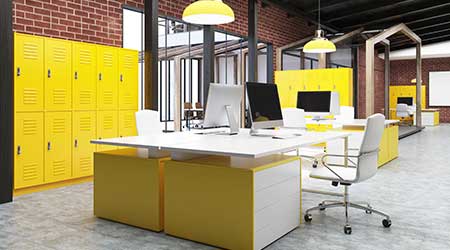« Back to Facilities Management Paints & Coatings Category Home
Why Color Matters in the Workspace
September 5, 2018
- Paints & Coatings
by Warren Bricknell
The impact of color on the way people perform in working environments is by no means a new area of research. And yet it’s a factor that’s often overlooked by facilities managers, who perhaps deem it a minor detail in the wider context of an office fit-out project. But the fact is that color elicits unique emotional responses in people. An entire discipline of psychology is dedicated to studying its effects on how we feel and behave, and facilities managers can use this information to their advantage in a professional context.
“Color in the work environment is one of the most important factors that influence the thoughts, moods, and behaviour of the people who work there,” says color therapy consultant Suzy Chiazzari, principal of the Holistic Design Institute. “Our sight is our primary sense, so the atmosphere on entering the office space will set the tone of one’s experience for the whole day.”
Chiazzari advises against using “an entirely neutral color palette,” adding that a monotonous office space can promote feelings of “drudgery and constriction.”
However, facility managers must consider the use of color carefully and take a number of factors into account, according to life coach Priscilla Elliott. “Color can either increase productivity directly or it can be used to alleviate problems in the office, which then indirectly increases productivity,” she says. “It very much depends on a) the type of business you’re in, and b) the ‘personality’ and issues within your current workforce.”
Color Theory
Breaking down the theory behind the shade chart, Sandra Sparrowhawk, color and style coach at Colourworx, says blue is “great to use in an office where communication is key” thanks to its associations with logic.
However, it should be used in moderation and in contrast with other colors. Alison Standish, author of Know Your Colour Personality, says: “Blue on its own can be very cool and make employees feel a little ‘blue.’ Pop this color with yellow or orange to bring in a bit of warmth to the environment.”
Meanwhile, green is a smart choice for facilities located in built-up, urban areas where “there’s not much natural light,” Standish adds. While the color is commonly used as a calming influence — for example, in hospitals — particular shades of the green, like olive green, can be used in the office to trigger a competitive streak in employees.
Yellow can be used to powerful effect in workspaces — both intellectually and emotionally — reports Standish. “It’s the color that helps us to organize and bring clarity to the decision-making process,” she adds. For this reason, yellow lends itself to areas of an office where concentration and focus are required — but it also has a positive influence on mood, so could be used effectively in social or break-out zones.
According to the findings of a 1979 study of American prisons, the color pink can reduce aggressive behaviour. And it can have a calming effect in a professional setting, says Elliott, who recommends subtle shades for “nurturing,” “sensitive” environments within the office. Brighter, bolder shades such as magenta work well in reception areas and meeting rooms where presentations to clients might take place, however.
And for social or “time-out” areas of an office, orange is an ideal color since it helps to activate the serotonin in our brains to produce feelings of happiness and joy, according to Standish.
Considered Choices
Many color psychologists and design consultants agree that using specific colours in discrete ”zones” is the most effective way to boost productivity, whether directly or indirectly.
Choosing the right shades for the workspace should form a key part of any business’s strategy, in order to get the best out of the people that work within it. Chiazzari concludes that working in a “color-diverse space” reinforces a feeling of wellbeing among employees, while teacher and color therapist Katherine Jones suggests the solution should be “to create zones of color to encourage areas of rest, creativity, productivity, and performance.”
In a similar way, changing the artwork in the office on a regular basis can engage and stimulate creativity, while encouraging staff to explore areas of the space they wouldn’t normally visit.
Far from being an arbitrary decision, using color in the office environment is a vital aspect of design and fit-out projects and therefore merits a great deal of consideration.
By creating zones of color, facilities managers can reflect the values and culture of their companies while supporting the working needs of staff across different departments and, in turn, boost performance and productivity.
Warren Bricknell is managing director of Dale Office Interiors.








